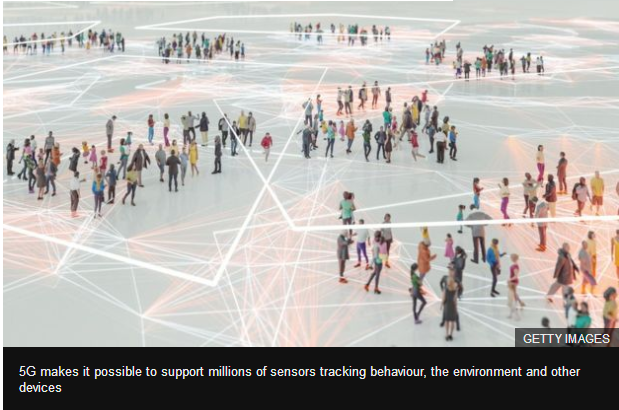2019-05-30
How fast will it go?-5G
The communications watchdog Ofcom suggests that in time 5G could offer speeds of 20Gbps.
That is fast enough to download an ultra-high definition 4K movie in less time than it takes to read its description.
But for now, you should temper your expectations.
To start with, the fibre lines EE is using to link each 5G site to its network have a total capacity of only 10Gbps, which must be shared around.
The network has suggested that, on average, users will achieve about 150-200Mbps downloads at launch, with lucky individuals hitting about 1Gbps at quiet times.
Samsung S10 5GImage copyrightGETTY IMAGES
Image caption
Samsung's S10 5G is the premium handset choice on offer from the networks after they pulled sales of a rival device from Huawei
So, wait times for such big files will still be measured in minutes rather than seconds.
Even so, this would still be an improvement on the 29.6Mbps that OpenSignal said that EE typically provided via its 4G network.
Of course, there's another way to measure speed and that is in terms of latency - the lag between sending a command and getting a response.
In time, 5G is supposed to provide latencies of one millisecond or less, compared with the 20-70 milliseconds on offer today.
That will make playing videos games powered by a cloud-based service a more responsive experience and will pave the way for new use cases - such as remote-controlled vehicles, surgical robots, and live-streamed virtual reality.
To start with, however, things won't be close to that level.
EE says to expect latency of about 20 milliseconds at launch, falling to 10 milliseconds within the next decade.
Is it just about faster phones?
No - though that's undoubtedly the short-term hook to attract subscribers.
One of the biggest long-term benefits of 5G will be the ability for mobile networks to provide more connections at once.
In theory, 5G will be able to simultaneously support more than a million devices per sq km (0.4 sq miles), a big jump over the 60,000-odd devices that 4G technology maxes out at.
But to make this possible, antennas will be needed all over the place - from lamp-posts to bus shelters, in addition to more of the rooftop masts we're already used to.
These in turn will support hundreds of thousands of data-capturing sensors that will allow the authorities and businesses to gain deeper insights about behaviour and provide "smarter" services.
Futurists envisage benefits such as a customer's smart-home automatically ordering the ingredients for meals that have been nutritionally tailored to their activities, while retailers make use of related data to ensure they have the right amount of stock to hand, thus minimising lost sales and goods going to waste.
Data peopleImage copyrightGETTY IMAGES
Image caption
5G makes it possible to support millions of sensors tracking behaviour, the environment and other devices
So, while 4G made it possible to start controlling internet-connected devices from afar, 5G should enable a multitude of machine-to-machine communications, allowing decisions to be made for people rather than by them.
Technology analyst Stephanie Hare says: "5G will make our physical world go from 'dumb' to 'smart'.
"It raises questions about how much choice and agency we will have, as companies and governments will have more information with which to target messages and options to us.
"The risk is that we won't be able to opt out."
What other changes will there be?
A little down the line, expect "network slicing" to become a new buzz-phrase.
This will allow operators to tailor different 5G contracts to different types of client by carving up their network into a variety of "virtual" slices, each of which will be isolated from the others and can be adjusted to guarantee different download speeds, latencies and bandwidth.
For example, a cloud gaming service provider might pay more for a contract that guarantees it super-low latencies, while the emergency services and broadcasters could be guaranteed that their 5G-based communications would not be disrupted by lots of people trying to watch YouTube at once.
EE suggests it will introduce this functionality in 2023.
Mobile networks are also likely to try to use the extra capacity they gain to offer a one-stop service that does away with the need for a separate home broadband connection.
Three's boss told BBC News last year that many customers had no need for the kind of speeds a fibre-optic cable delivered but would find 5G superior to what was possible over a copper phone line.
"It's expensive to dig up roads. It takes a lot of time and money," he said.
"It's much cheaper and quicker to provide that connectivity via a wireless connection."
























